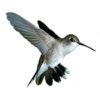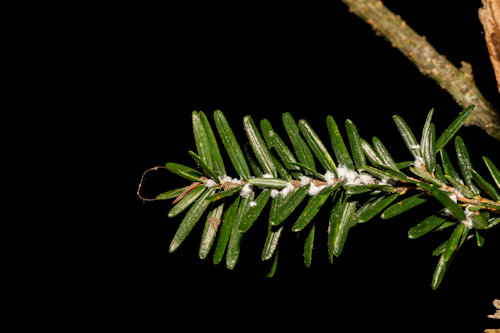What Is the Threat
The Hemlock Woolly Adelgid (HWA) is an invasive, aphid-like insect that invades North American Hemlock trees. Invisible to the naked eye, it pierces the tree at the base of its needles and sucks the sap. This inhibits twig growth and can kill the tree over time.
Young nymphs, also called crawlers, are reddish-brown in color, while adults are darker. The best way to identify this disease is the presence of tiny, white egg sacs, or ovisacs. Fuzzy and wooly in texture, these sacs are most visible in the winter months, when the pest feeds and reproduces.
Where Is the Threat
The HWA originated in Asia. The first known U.S. infestation occurred near Richmond, Virginia in 1951. Since then, the species has continued to invade the Eastern Hemlock forest all along the eastern U.S. coast as far north as Maine and as far south as Georgia.
It has also been spotted in parts of Michigan, and experts believe its range is expanding due to climate change. This pest goes dormant during the summer and completes two asexual generations each year: one in the winter and one in the spring. Both of those generations overlap in the spring.
Symptoms of Hemlock Woolly Adelgid
While the pests themselves aren’t visible, the first sign of an HWA infestation will be the fuzzy white ovisacs. These will appear as white, cotton-like masses all along the twigs, as well as on the base of the needles.
These populations tend to be denser on the tree’s lower limbs, but they can occur anywhere. As the insects continue to feed on the twigs, they can cause the foliage and limbs to fade, thin, and eventually die off. This progression usually begins at the base of the Hemlock tree and gradually moves upward.
Without proper treatment, a tree infected by HWA can completely die within three to five years. This fate is certain, as this invasive species can completely deprive the tree of the critical nutrients it needs to survive.
What to Do About the Problem
As soon as you notice the telltale white masses near the growth of your Hemlock tree, it’s important to contact our team as soon as possible. We’re well-versed in this tree disease and are prepared to help clients in and around the Charles, Calvert St. Mary’s, and Anne Arundel County areas.
Ideally, treatment for Hemlock Woolly Adelgid should occur in the fall or spring, when the Hemlock tree is transpiring, the soil is moist, and humidity levels are relatively high.
We can apply a trunk injection treatment that will eliminate the pests and increase the tree’s vitality. The treatment works in conjunction with the tree’s vascular system for optimal uptake. While most of the pests will die within the first few weeks, HWA mortality can continue for up to two years.
In addition to the injection treatment, we will also provide a follow-up treatment to strengthen the tree’s resistance and prevent future infestations.
After application, you may notice that the cotton-like masses still remain near the base of your tree. These will slowly turn gray in color as the pests die and the tree heals. Eventually, new twig growth will occur in healthy trees.
NEED HELP?
If you live in Southern Maryland, or Northern Virginia
FIND YOUR SOLUTION HERE
People, Pet & Pollinator Safe! Pest control for people who care.

